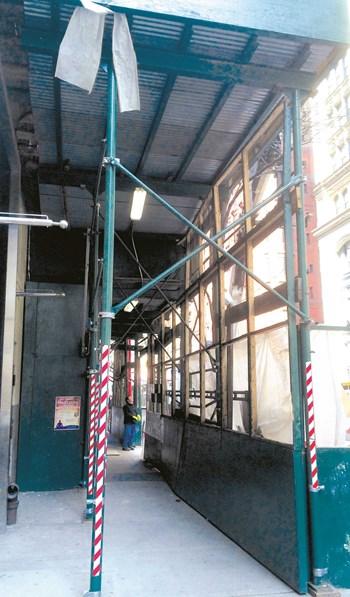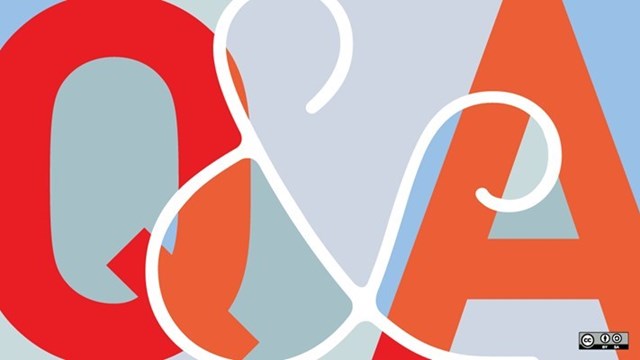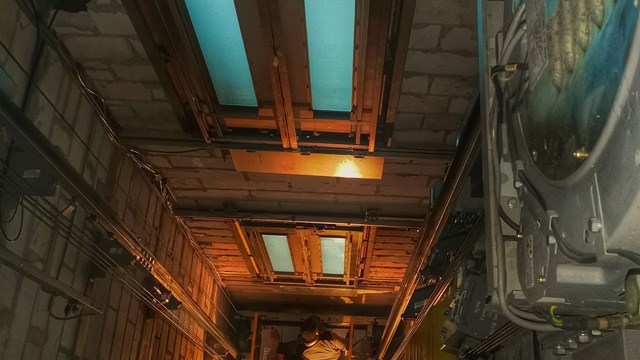
Walk down any street in any of South Florida’s major cities and you may have to step around or go under one of the ubiquitous steel-and-plywood structures that shade urban sidewalks, more often than not festooned with wheat-pasted posters for everything from the hottest nightclub parties to new movies opening this weekend.
They’re called sidewalk sheds and scaffolds, and these blue or green plywood platforms boosted up above street level by crisscrossing metal poles and girders are usually installed on buildings in the midst of an exterior repair program.
What’s That Thing?
“Sheds are regularly used to protect workers (and the public, depending on the circumstances) from falling material, equipment, tools, construction debris etc.,” says Michael D’Aquino, a spokesman for the U.S. Department of Labor’s Occupational Safety and Health Administration (OSHA).
By contrast, a scaffold is a temporary work platform, either suspended from the roof or some other part of a building or built up from the ground, typically with a system of pipe sections. Both types of structures are often in place for years at a time, and can become tremendous eyesores, with flapping plastic and cracked, peeling paint that erode even the most luxurious building’s curb appeal.
“Pieces of scaffolding include, but are not limited to, base plates, mudsills, screw jacks, planking, cross-bracing, uprights, guardrails, toe boards, tie backs, outriggers, means of access (ladders), and side frames,” D’Aquino explains.
There are several types of scaffolds available for use, each dependent on the project being done, according to Alan Kline, the owner of Boston-based Lynn Ladder & Scaffolding Co. Inc. and a board member of the national Scaffold Access and Industry Association (SAIA). “You’ve got scaffolding just for contractors that do framing and build houses, then you’ve got steel scaffolding, which is frames and braces. Then you’ve got suspended scaffolding, which you wouldn’t use on a new building. Then you have mass climbers, which are always used on bigger buildings. You’ve got a lot of different stuff you can use.”
Florida’s Department of Business & Professional Regulation (DBPR) last updated Florida’s building code in 2010. While local government is free to create rules and regulations regarding scaffold and sidewalk shed usage and safety, OSHA sets federal job site safety and health standards that all U.S. states must follow which supersede any local laws.
Safety First
So, why are they needed? These structures are designed to prevent injuries and save lives.
In early April, two construction workers nearly escaped a potentially deadly scaffold accident in early April when their scaffold was left dangling 30 stories above ground. The accident, which happened at The Beach Club Condos in Hallandale Beach, was caused by a motor failure.
According to OSHA, “An estimated 2.3 million construction workers, or 65 percent of the construction industry, work on scaffolds frequently. Protecting these workers from scaffold-related accidents would prevent 4,500 injuries and 50 deaths every year, at a savings for American employers of $90 million in workdays not lost.” In fact, citations for scaffold construction and general requirements’ violations were the third most issued by OSHA in 2013.
Construction work that necessitates the use of scaffolding is inherently more dangerous than another job that doesn’t require one to be elevated at great heights, but is there a type of scaffold that is safer than others? Kline says no, and maintains that scaffold safety is mostly dependent on those using the equipment.
“The way OSHA reads is on every single job for the entire shift, you must have a competently trained person who can identify the hazards of the job and has the authority to correct them,” Kline says. “If it’s a job over 25 feet in the air, it has to be designed by a professional engineer. And you would still need someone on the job site to watch what’s going on. A typical scaffolding accident would be somebody falling off the plank because it didn’t have the guard rails on it, which goes back to the competent person being responsible,” Kline says. “That’s why we don't lose cases. We give them the equipment and whether they choose to use it or not, it’s the competent person’s responsibilities. There are a lot of issues, too, with kids under the age of 25 that do construction work that are alcoholics, drug addicts, just plain stupid punks,” Kline says.
“We have never had any equipment collapse, because we follow OSHA and have a well-trained workforce of men and women at Carousel,” Michael Bianchini, vice president and owner of Carousel Development & Restoration, Inc. in Delray Beach, says.” Unfortunately, others in the industry have encountered those types of problems. We are constantly updating our procedures to be OSHA-compliant and for the safety of all.”
The pros say they believe continuing education is the main key to scaffold safety. “People in our industry need to be very well-trained and prepared to do everything they can on a job site, because the nature of our business in inherently dangerous,” says Peter Dyga, the president and CEO of Associated Builders and Contractors, Inc., Florida East Coast Chapter. “We definitely encourage members to train. We do a lot of safety and fall protection training.”
As an SAIA board member, Kline also regularly participates in scaffold safety courses and seminars the national organization provides. According to SAIA’s website, the organization works to “be the unified voice of the scaffold and access industry; promote safety by developing educational and informational material; conduct educational seminars and training courses; provide audio-visual programs and codes of sage practices and other training and safety aids; work with state, federal and other agencies in developing more effective safety standards; reduce accidents, thereby reducing insurance cost; and assist our members to become more efficient and profitable in their businesses.”
Insurance Issues—Who’s Liable?
A permit is required to erect a pedestrian scaffold in Miami Beach. While specifics might differ between municipalities, generally, the city in which the scaffold will be erected will require proof of a license and insurance before a permit is issued. For example, the City of Miami Beach’s Public Works Department requires permit applicants to provide a current certificate of insurance liability/worker’s comp coverage to be approved by the city’s risk management division.
Construction professionals say that with respect to scaffolds and other equipment used by construction crews, condominium owners and associations are generally insulated from any resulting liability or payout when a worker or bystander is injured in an accident.
“I think that most people in construction take their responsibility to their employees and their safety very seriously,” Dyga says. The weight that would plague on somebody’s mind would be, to me, the biggest consequence, but there are legal consequences as well as far as lawsuits and OSHA fines. Accidents happen, but if you aren’t taking the proper precautions and steps to make sure workers are protected, you could be fined,” he says.
“Legal consequences with respect to the OSHA Act will depend on the responsibilities of an employer at a worksite,” D’Aquino says. “Based on the facts gathered during an OSHA investigation, a company who is identified under at least one of the criteria under OSHA’s multi-employer worksite policy (as an exposing, creating, controlling, and/or correcting employer) can be subjected to actions under the OSHA Act.”
While such contractual provisions are relatively standard in the industry, it is always a good idea for all homeowners and condo boards to look for such language in a contract before work even begins. As a form of best practice, Keith Carroll, an agency principal at Rick Carroll Insurance in Jensen Beach, urges associations to create a contract with a general contractor prior to the commencement of a project to further ensure protection from vicarious liability via a hold harmless indemnification agreement. General liability insurance is also a must when it comes to protecting an association for liability.
“For general liability, it would typically be at least $1 million. It’s the standard, if you will,” Carroll explains. “Any subcontractor or vendor doing work on behalf of the association should be required to provide proof of general liability coverage, workers’ compensation coverage and automobile insurance when appropriate. If that contractor is irresponsible in a couple of different fashions—let’s say they are on the scaffold and drop a bucket and hit somebody on the head, we want them to be responsible for that payment to the claim, not the association. If one of the employees of the construction company is injured, we want proof of workers compensation coverage so the employer’s policy pays the injuries, otherwise the injured employee could come after the association.”
Associations without any paid employees might think workers’ comp is not an option for them. Such is not the case, Carroll says. “In the event the association doesn’t have any employees, I recommend they still maintain what’s called a minimum premium workers compensation policy.”
Post No Bills
While some cities like New York City and Chicago have strict “Post No Bills” laws to prevent advertisements from being posted at constructions sites, this is not the case for any Miami-Dade County-based cities. According to the Construction Law and Litigation department of Becker and Poliakoff (a national law firm with 13 locations throughout Florida), there aren’t any statewide regulations regarding this issue, rather, it is left up to local municipalities to govern the issue.
Scaffolding and construction areas often have signs not to post “bills” because they add to garbage and debris in the area. Perhaps it wouldn’t be so annoying to pedestrians if they weren’t plastered with posters and signs from top to bottom, harming the look of a neighborhood. Some pros say that from a functional perspective, bills or posters on a scaffold or shed can be a safety hazard because they may prevent workers or city inspectors from looking at all aspects of the support system.
“Here at Carousel we pay strict attention to all post no bills signs. The penalties range from civil to criminal exposure,” Bianchini says.
However, it is common for the contractor of a project to put up their own advertising.
“Whoever controls the scaffolding would control the advertising and leasing. Such deals are negotiated between the entity that controls the scaffolding and the advertiser.”
In urban areas known for large residential buildings and skyscrapers, there will likely not be a time when it is completely devoid of sidewalk sheds and scaffolding but one day, maybe the look will be more appealing. The important thing to remember is that they keep the people of the Sunshine State safe and sound.
Enjolie Esteve is an editorial assistant at The South Florida Cooperator. Keith Loria, a freelance writer, contributed to this article.






Leave a Comment